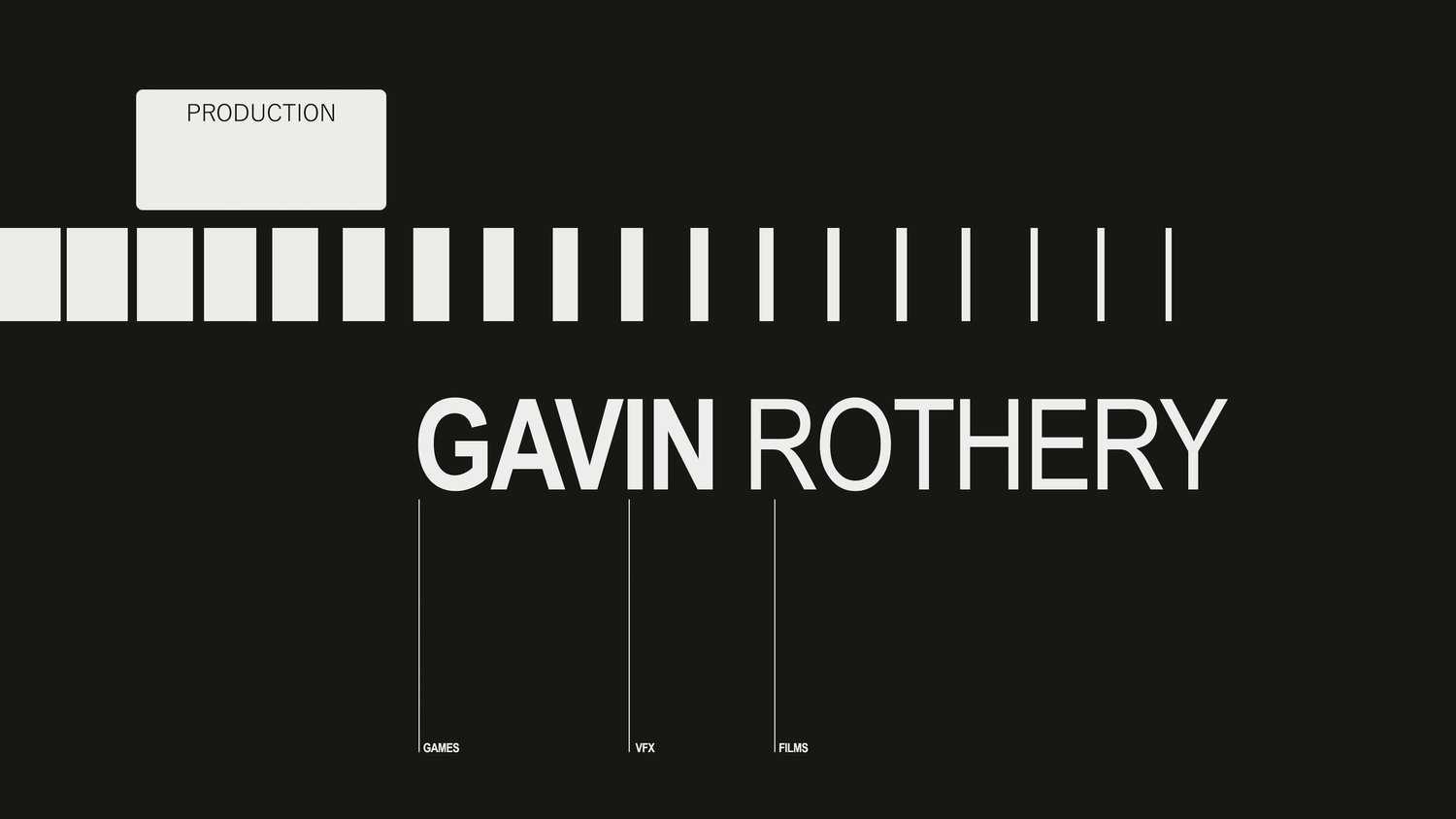I thought I'd take the opportunity to show you a bit more about how we worked out what we were going to do with the vehicle VFX and lunar exterior shots in Moon. Particularly regarding the practicalities of actually getting them on film, as I ended up doing a lot of setup work to ensure the shooting went smoothly and it's not something you'll be hearing about anywhere else. I'm in a weird position in regard to Moon, as I have so much data from the film sat on my hard-drives at home that just doesn't exist anywhere else. When I found these folders containing all these files I thought that an insight into this process might be of interest to any of you potential filmmakers out there.
As we were predictably under-resourced I took it upon myself to block out as much of the film as I could in CG so that we could be more prepared for shooting. Shooting requires a plan and shooting VFX requires more of a plan. Until I'd got all this sorted I couldn't be 100% confident that it was all going to work, so I sacrificed yet more of my already minimal sleep and boshed through it night after night whilst we still had the models under construction. This all ended up being a bit rough and ready but I'd gotten used to this being normal Moon operating tempo by now and I was in the zone and able to stay awake on 2-3 hours per night. I really needed to be comfortable that we had a plan going into the model shoot as we only had eight days in there so this became preferable to lying unconscious wrapped up in my lovely warm duvet having my hair stroked in dream-world by a robot unicorn. Given that the first day of the model shoot was actually a test day, we really only had seven. Over this period we had to shoot a hundred and forty three setups with all kinds of combinations of models and all on a rostrum 32x24 feet that needed to be re-dressed frequently including ripping our Sarang set in and out of the middle of the table. Just thinking about all this now makes me want to have a word with myself and go put myself to bed.
Below are the original animatic block out frames that I did for scene 145 where we see Sam 2 take a dying Sam 1 back to the Rover crash site so that when the "rescue" team arrive they find the dead space-clone they were expecting. You might notice that in these original block outs things are a bit different from the way they appear in the film. This is because we were moving forwards at such a rapid rate and my work was covering so many areas that I didn't have time to keep everything 100% up-to-date. You can see the original Rover 1 under the Harvester whilst the two Sams pull up alongside in a more advanced design of Rover 3. Also, you'll notice the crashed Rover 1 is on its' side and the access is simply kneeling down and poking your behelmeted head through the hatch.

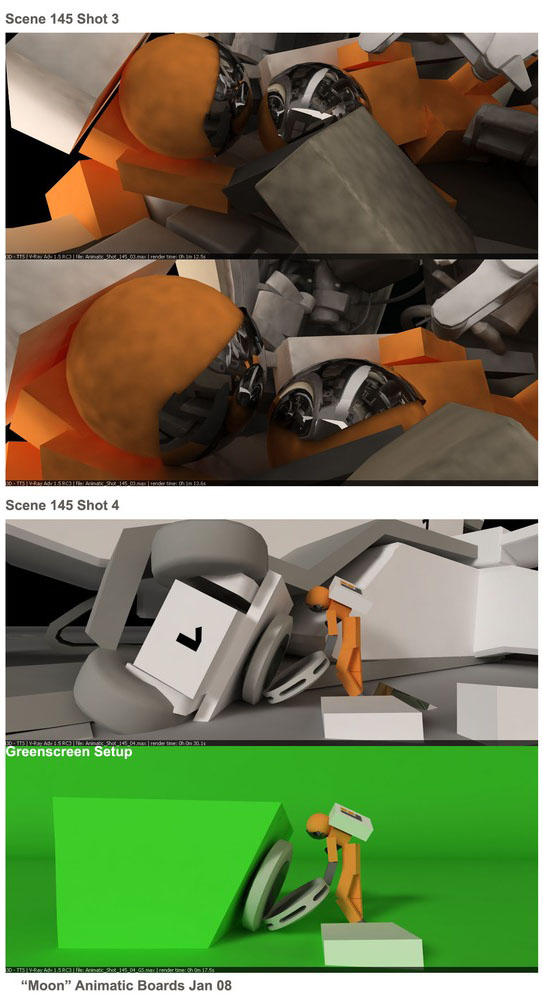

You'll see that a lot of the frames have a weirdy looking green version underneath them. This is an accompanying VFX animatic and is intended to show the crew exactly what we'll need to have ready on the set before we start shooting. They turned out to be a really good way to communicate clearly with the set-builders, as they tend to not get too deep into the technical side of VFX. They were also good for the rest of the crew to get a general understanding of what was going on. I would pin these up on a board in the sound stage at the start of every day, as they were really useful in establishing our running order. When you have your shots printed out nice and big and pinned up on the wall like this they are very easy to get an overview of and group into similar setups. This can speed you up quite a bit over the course of a days shooting.
Moon was an effects heavy production and I always find it preferable if the people I'll be working with on-set have an understanding of why I am asking for things to be done a certain way. Some people see VFX as spooky magic made of gossamer and spiders dreams but I find that if you can engage with people a bit and make them understand why they're painting these things green, etc, they'll generally get that extra bit more interested in what they are doing and give you that extra bit more. These green-screen block outs were really useful in showing stagehands and crew what we needed built, where the divides were between green-painted props and "real" bits and pieces, the kind of range of movement and weight they need to bear, etc. These things might sound obvious but they are exactly the kind of thing that will get misinterpreted and you'll turn up on stage with the rover hatch painted bright green when it needed to be realistic which will stop you from shooting that shot. Or the rover-roof won't be safe to bear a persons' weight, as the construction crew didn't think anybody would be standing there. Stuff like that. Even framing up a green-screen shot can be hard if there's nothing to go on, but with these simple references we knew where we needed to put the camera and also how much floor-space we needed, something that can be easily misunderstood without a visual reference. Working like this is a really good way of maximising your time and getting a lot of value out of a few cosy nights snuggled up with a cup of tea and your favourite computer.
The motion sequence above is how the animatic sequence for the body-replacing scene was as we went into shooting. As you can see, it's been tweaked quite a bit and has updated designs added and is generally a nicer piece. I tried to get as much time with the animatics as I could so I could spend time positioning cameras and setting up the shots to make sure they were right. This development work was pretty fraught as we didn't have much time and there was only me covering it, but you can see how closely the final animatic resembles the end-filmed result. Preparation win.
A few things changed as we were moving along. Duncan and I were both concerned about the crash sequence, as we didn't have any budget to produce models that would be doing anything specific. Our miniatures, lovely as they are, are basically toy cars with some lights on that we pulled along a big tabletop with wire. We knew we'd likely be relying on cuts in the edit to make the crash sequence work. As it was it almost didn't.
When we were shooting the miniatures, if we needed anything extra that wasn't on the call-sheet, I'd wait until we were shooting something similar and then jump in with a quick request. As we'd be al set up for shooting something similar it kept setup times down to a minimum and we grabbed quite a few extra bits and pieces we really needed to get some of our scenes working. With the Rover crash we fed the wire that pulled Sams' vehicle through a part of the side of the Harvester wheel mechanism and back out the other side at an angle. This way we could pull the rover into the side of the Harvester even though it wasn't designed to do so. I knew it would only be used for half a second or so and we grabbed it as an extra shot. It only slowed us down by perhaps twenty minutes, which, in this case was totally worth it. We got the shot of the Rover heading into the Harvester tracks and hitting it from above and behind which really helped the scene to work.
When I was putting the animaitc scenes together, they immediately showed a hole and this was the missing element that the scene needed to work. Creating the new shot in the animatic showed me immediately that the hole had been filled and so I set out to the model shoot with the agenda of grabbing a few extra bits of footage like this. It's all well and good having a plan but you still have to think on your feet and be honest with yourself. When something could be better, get off your arse and make it better. Otherwise it'll get done half-arsed and when you see it up on the screen it's too late to change it and you'll just have to live looking at it forever. Unless you're George Lucas.
The animatics were incredibly useful for these sorts of things. As we were working on minimal budget, we were only shooting things we were sure we needed . We were shooting them as fast as we were able, whilst making sure they were still what we intended and needed for the film. Consequently, we didn't have loads of spare footage lying around and so we were constantly at risk of getting in the edit and not having any options to fix things that weren't working, as we'd have no additional footage to work with. The animatics were great for this as I could put scenes together and tell immediately if they worked or not. I spent quite a few late nights in my bedroom just trying out scenes and moving shots around so I could be happy we had nice sequences and I could get my two hours sleep. Now and again it'd be clear we needed an extra shot to make the sequence work and so I'd just knock it together in 3D and re-cut it and see if it worked. It's kind of like peeking into the future to see if the sequence you intend to film is going to work out or not. When you're making films it's handy being able to save your own arse like this becasue you don't want to be in the edit suite a couple of weeks later realizing you've forgotten to shoot somthing. If you have to go back, it's going to kick you right in the bank account.
The examples below show a random scene in the Rover cockpit and you can see from these angles that the scene will cut together just fine. I was taking into accont camera setups and reset times, as one big trap to fall into with animatics is that you just re-site the camera with every cut. When you get on-set this means that after every shot you'll be moving the camera, light, etc and have perhaps half an hour or more of down time where you're not shooting anything. I was trying to not move the cameras around too much and keep them in a few similar positions, which meant that we would be able to shoot the scenes quickly, and in groups. Moving the camera really is a large part of downtime on a working set. You can see from this sequence that we'd only need to have one side of the rover removed and the camera can stay in roughly the same place whilst we shoot the whole scene. Things like this really help the AD team get the shooting organised and by you understanding what everybody else will be doing on the actual shoot you can really help everybody else out. If you're careful, you can strike the balance of getting just what you want artistically whilst simultaneously building all sorts of timesaving measures into the actual shoot itself. It's quite likely that nobody will ever realize you ever did this as people tend to assume these kind of things happen co-incidentally, so don't expect anybody to say thanks. Just concentrate on making everything better wherever you can and it will all work itself out.
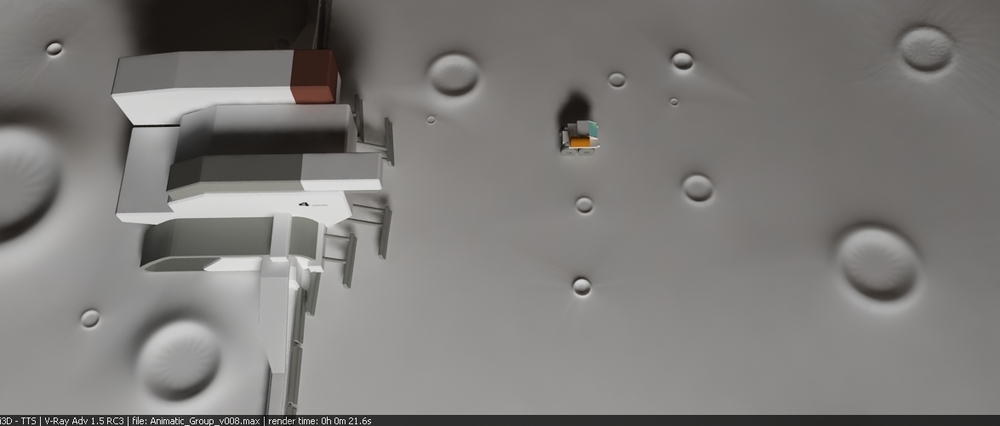
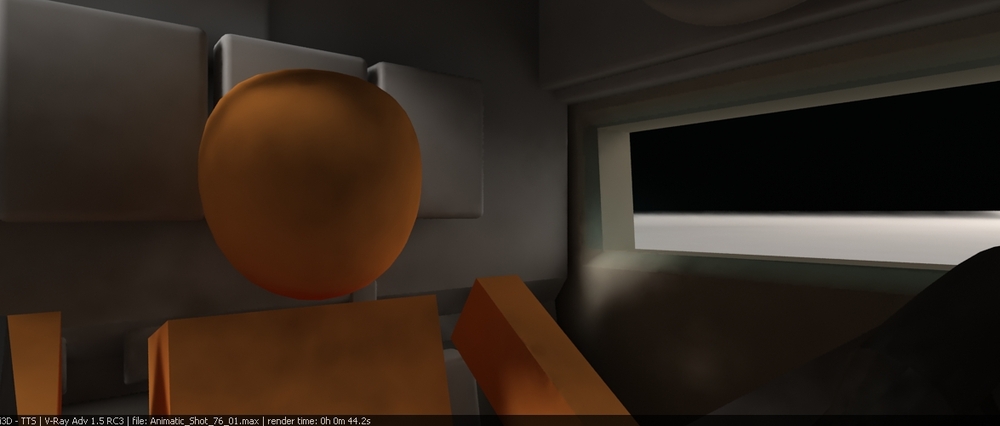

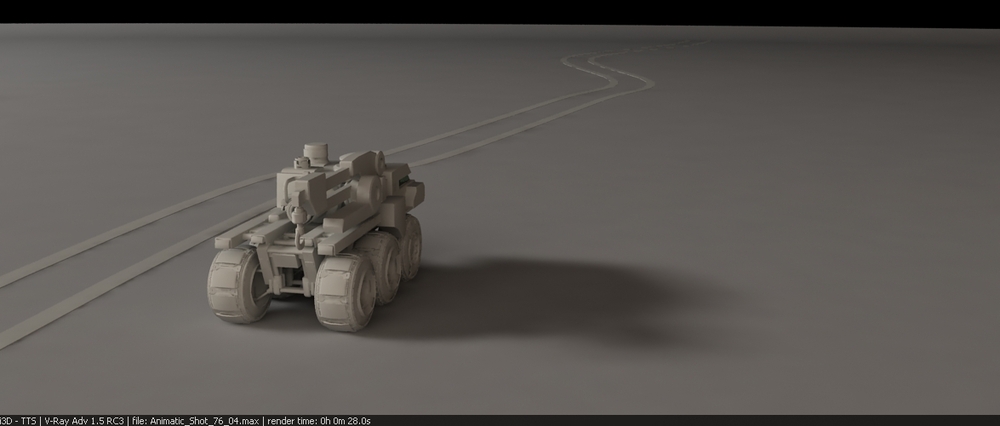
Sometimes VFX issues are also made clear at the animatic stage. The following shot is from the scene where Sam 1 looks up at the jamming tower. It was clear from this that we would be having a big, reflective, shiny shiny helmet right smack bang in the middle of the frame. Not only that but you can get an idea of the kind of distortion that's going to be needed on the fake-reflection of the tower that'll be getting composited in later. So best not get the camera crew in the reflection then. Lots of big black drapes with the camera poking through sorted that one out. You really have to have this sort of thing sorted out in advance or you'll never get through your shooting schedule on time and on budget.


One thing that can always happen with rough art like this is that you might not be there to explain everything. This only happened one time on Moon and the mis-understanding was quite comedy. Have a watch of the clip below.
This shot is from the scene where Sam calls Eve back on earth. He has just hung up on her and starts punching the dashboard of the Rover because he's upset and frustrated. When this appeared on the call-sheet, the description was "Sam is frightened". Of course he is.
The animatics were a really rewarding part of the filmmaking process for me as I got to immerse myself in my computer for a few hours at a time and get some nice sequences together. I'm really happy with the way the whole thing came out and I hope this insight into how this stuff was planned was interesting. I know it's easy to look at it as a body of work and see a load of crudely made CG puppets unconvincingly animating around but for the time and resources we had available they really saved our arses and brought up all kinds of issues that we were able to solve ahead of time and hence get the film made. These little CG stick-men showed us so much of what our film was going to be before we'd even set up a camera. So next time you're at the pub have a drink for stick-man CG Sam, the hardest working pixel-person on the Moon.
